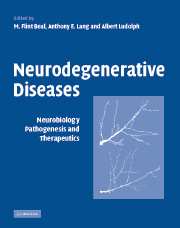Book contents
- Frontmatter
- Contents
- List of contributors
- Preface
- Part I Basic aspects of neurodegeneration
- Part II Neuroimaging in neurodegeneration
- Part III Therapeutic approaches in neurodegeneration
- 22 Gene therapy
- 23 Stem cells and cell-based therapy in neurodegenerative disease
- 24 Necessary methodological and stem cell advances for restoration of the dopaminergic system in Parkinson's disease patients
- Normal aging
- Part IV Alzheimer's disease
- Part VI Other Dementias
- Part VII Parkinson's and related movement disorders
- Part VIII Cerebellar degenerations
- Part IX Motor neuron diseases
- Part X Other neurodegenerative diseases
- Index
- References
22 - Gene therapy
from Part III - Therapeutic approaches in neurodegeneration
Published online by Cambridge University Press: 04 August 2010
- Frontmatter
- Contents
- List of contributors
- Preface
- Part I Basic aspects of neurodegeneration
- Part II Neuroimaging in neurodegeneration
- Part III Therapeutic approaches in neurodegeneration
- 22 Gene therapy
- 23 Stem cells and cell-based therapy in neurodegenerative disease
- 24 Necessary methodological and stem cell advances for restoration of the dopaminergic system in Parkinson's disease patients
- Normal aging
- Part IV Alzheimer's disease
- Part VI Other Dementias
- Part VII Parkinson's and related movement disorders
- Part VIII Cerebellar degenerations
- Part IX Motor neuron diseases
- Part X Other neurodegenerative diseases
- Index
- References
Summary
In the past 20 years, the development of molecular biology and genetic engineering has led to new horizons in therapy. Introducing therapeutic nucleic sequences into the organism for curing a disease is a very attractive approach for treating both inherited and acquired diseases for which classical drug therapy is not satisfactory. Although the idea is simple, many hurdles have to be overcome before clinical applications can be envisaged. The transfer vector and the therapeutic gene are the major determinants for successful therapy. An ideal vector would be easy to produce, and safe for the patient and the environment. Ideally, it must transduce only the target cells and do so efficiently. It should be possible to readminister the vector to the patients without triggering a deleterious immune reaction from the host, and the transgene has to be expressed at an appropriate level for the desired duration. The optimal characteristics of the gene depend on the disease. For a recessive monogenic disease, a wild-type allele of the mutated gene is generally required. For a dominant monogenic disease, sequences that inhibit the expression of the mutated allele, or that counter its physiological effect may be used. For many complex diseases, whether inherited or acquired, there are several potentially therapeutic genes. A therapeutic gene must be effective, but have minimal side effects. In particular, it should not lead to an immune response from the host organism, and this can be a major problem for recessive monogenic diseases, where the patient had never been in contact with the wild-type gene product.
- Type
- Chapter
- Information
- Neurodegenerative DiseasesNeurobiology, Pathogenesis and Therapeutics, pp. 329 - 346Publisher: Cambridge University PressPrint publication year: 2005

